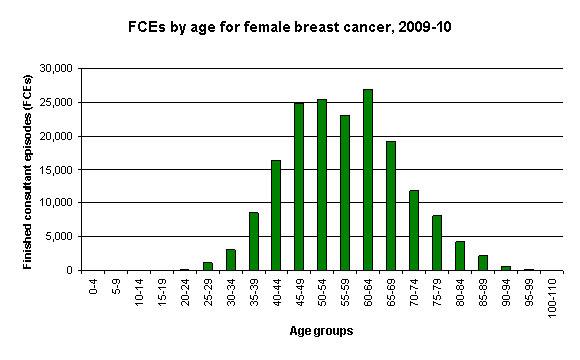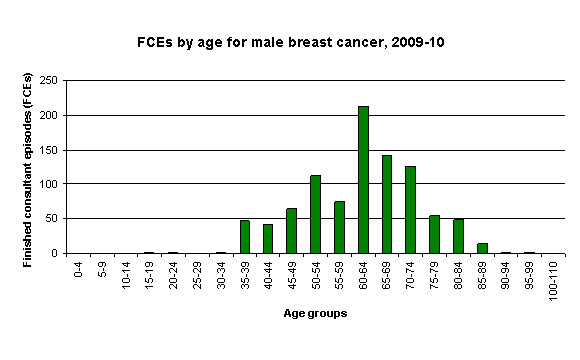IN THIS SITE...

- NHS Choices: Breast cancer - female
- NHS Choices: Breast cancer - male
- Inpatient data
- Self Service
HES on... Breast cancer
According to NHS Choices, in the UK breast cancer:
- is diagnosed in around 46,000 women each year.
- is diagnosed in around 240 men each year (less than 1% of all breast cancer cases).
This article gives an overview of the condition and highlights related 2009-10 HES data.
What is breast cancer?
Breast cancer is the uncontrolled growth of breast cells. The term 'breast cancer' refers to a group of breast cancers that can develop in any part of the breast tissue. There are two general forms of breast cancer:
- Non-invasive: where the cancer cells have not spread
- Invasive: where the cancer cells have spread to the surrounding breast tissue, or further.
If breast cancer is not treated, the cancerous cells can either spread within the breast or to other parts of the body.
Who does it affect?
HES data for 2009-10 shows that, in England, women are the most likely to be admitted to hospital with the condition. It also shows that hospital admissions for breast cancer become more common with age, with most admissions occurring in women over 45 and men over 60 (see graphs below).
 |
 |
HES facts and figures
HES data for breast cancer (diagnosis code C50 in ICD-10) show that in 2009-10:
- just over a third (36 per cent) of hospital admissions for breast cancer are from waiting lists
- the average (mean) time that patients remained in hospital was 3.9 days
- where procedures were carried out on admitted patients, the most common were:
- procurement of drugs for chemotherapy for neoplasm in bands 6-10 (X71 in OPCS-4.6)
- procurement of drugs for chemotherapy for neoplasm in bands 1-5 (X70 in OPCS-4.6)
- other excisions of breast (B28 in OPCS-4.6).
- it was responsible for 176,962 episodes of admitted patient care, accounting for 173,653 occupied bed days.
Mastectomies and lumpectomies
The following table gives numbers of breast excision procedures (including mastectomies and lumpectomies) that were recorded as main procedures or interventions in 2009-10 for patients with a primary diagnosis of breast cancer.
| Mastectomies and lumpectomies recorded as main procedures and interventions | ||
|---|---|---|
| Procedure code (OPCS-4.6) | Procedure name | FCEs |
| B27.1, B27.2, B27.3, B27.4, B27.5, B27.6, B27.8 and B27.9 | Total excision of breast (mastectomy) | 13,964 |
| B28.3, B28.7 | Other excision of breast: excision/wire guided excision of lesion of breast (includes lumpectomy) | 2,203 |
| B28.1, B28.2, B28.4, B28.5, B28.6, B28.8 and B28.9 | Partial excision of breast (not all are mastectomy or lumpectomy) | 19,584 |
More information on this topic is available from NHS Choices through the following:
- breast cancer in females
- breast cancer in males
- live well with breast cancer

